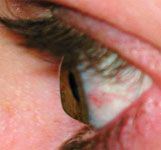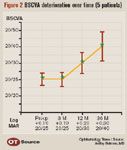Article
Post-LASIK ectasia can be unpredictable
Baltimore—Some patients with preoperative risk factors for developing post-LASIK ectasia never develop the complication, while other individuals without evidence of topographic abnormalities or pachymetry values associated with surgical risk do.

This suggests that some intrinsic structural properties of the cornea not detectable with current screening methods may be important determinants in the development of that condition, said Ashley Behrens, MD, at the 18th annual Current Concepts in Ophthalmology meeting in Baltimore.
"Ectasia is one of the most feared postoperative complications of LASIK," said Dr. Behrens, cornea surgeon and researcher at the Wilmer Eye Institute, Johns Hopkins University School of Medicine, Baltimore.

Recently, Dr. Behrens and colleagues at the Wilmer Eye Institute have launched several protocols evaluating whether biomechanical corneal characteristics (corneal hysteresis) measured with a new instrument (Ocular Response Analyzer, Reichert) may be used to predict a risk for post-LASIK ectasia. The trials include lab studies in animal and human cadaver eyes evaluating corneal responses to various surgical insults, and also clinical studies of patients undergoing excimer laser refractive surgery and endothelial cell transplantation with the posterior lamellar keratoplasty approach.
"Although patients who undergo that transplant procedure might be expected to be at risk for postoperative ectasia due to posterior cornea instability, in follow-up so far they appear todo quite well," Dr. Behrens said. "Therefore, we are interested in studying whether there are differences in wound healing responses depending on the orientation of cutting of the cornea's collagen fibers and perhaps whether the perpendicular cuts made in posterior lamellar keratoplasty afford some benefit for biomechanical stability.
"If so, that information might suggest a new approach for treating keratectasia in some of these patients," Dr. Behrens said.
Recognized warning signs
The development of "iatrogenic keratectasia" in a post-LASIK patient was initially described in 1998 by Theo Seiler, MD. Based on his observations, Dr. Seiler proposed that a 250-μm residual stromal bed limit should be respected to avoid that complication. Other investigators have proposed total central corneal thickness (CCT) as the basis for identifying patients at risk for post-LASIK ectasia and suggested a more conservative approach, refusing surgery on individuals with a central corneal thickness below 500 μm.

Newsletter
Don’t miss out—get Ophthalmology Times updates on the latest clinical advancements and expert interviews, straight to your inbox.




